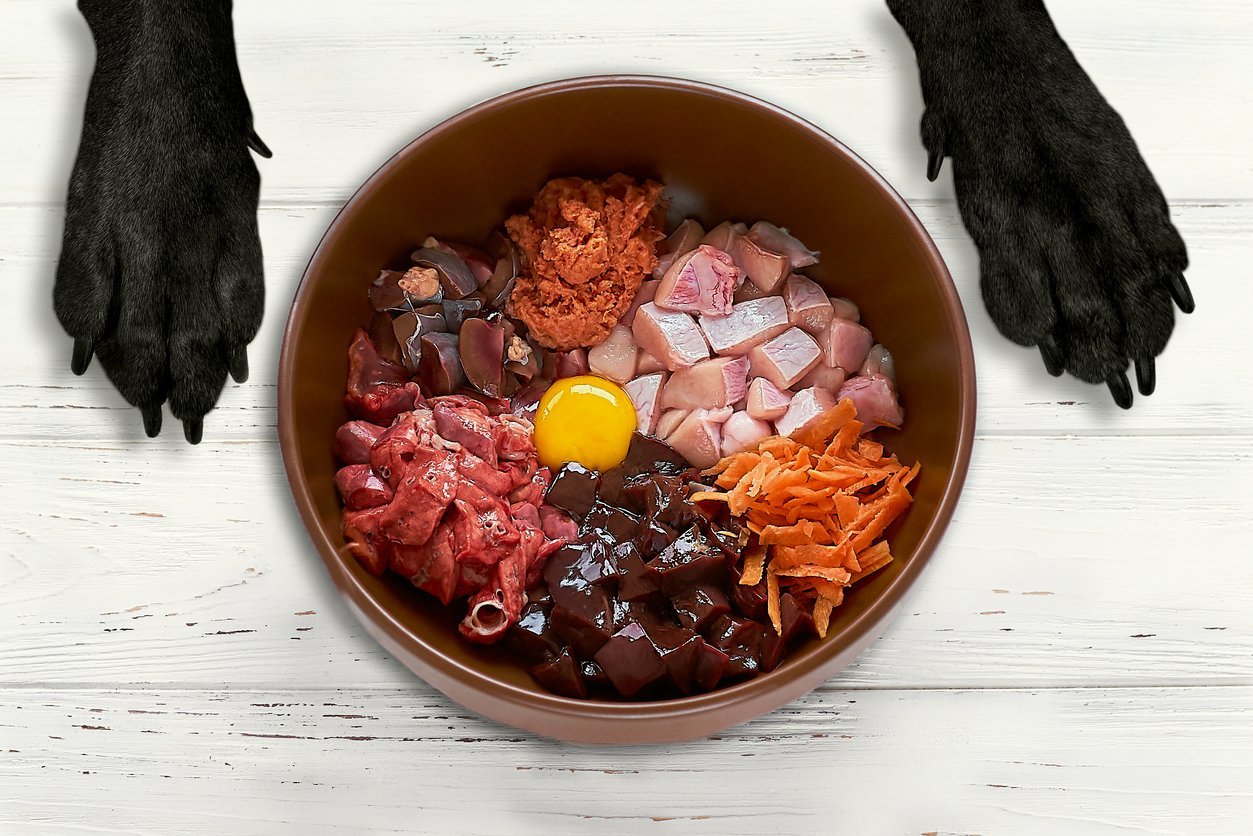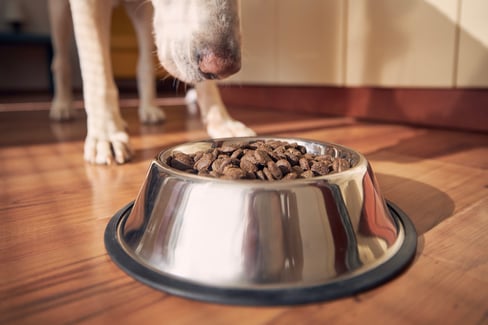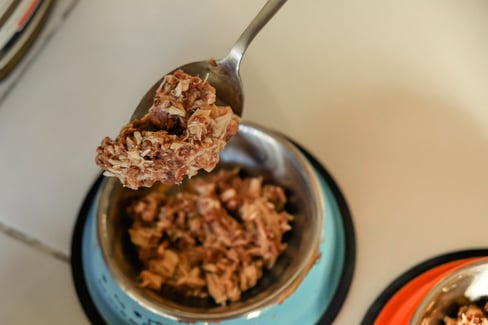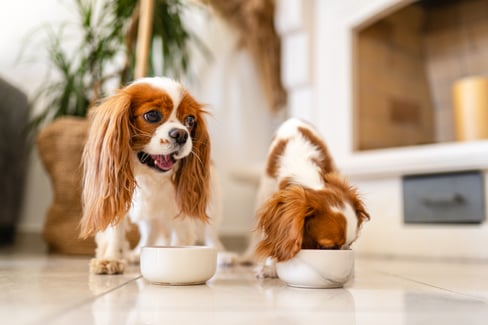Table of Contents
You may have overheard people talking about it at the dog park, or maybe you’ve read about it online – either way, the raw food diet for dogs is becoming more and more popular.
Harkening back to the times when dogs hunted for prey and ate mostly raw meats, the dog raw diet is an option to feed the modern dog, too.
But there are a few things to know and to keep in mind before you opt for this specialty diet for your pup. Whether you’re seeking a raw food diet for small dogs, large dogs, senior dogs, or looking to treat a health condition with a raw dog diet, you’re in the right place.
What is a Raw Food Diet for Dogs?
The raw food diet for dogs is a specialty diet designed to mimic the carnivorous, ancient diet dogs had before they became domesticated. This includes feeding your dog raw meat, organs, and bones, among other ingredients rather than commercially prepared foods. There are even some freshly prepared, packaged raw diet dog foods available for busy pet parents.
In raw dog food for beginners terms, a raw diet for dogs may consist of feeding:
- Uncooked muscle meat from animals
- Uncooked animal organs
- Animal bones ground up
- Protein-rich ingredients such as fish and eggs
- Whole vegetables and fruits that are safe for dogs
Various methods to prepare and serve these types of ingredients exist. The sky is really the limit, and you can cater to your dog’s personal needs as well as their taste. It can be especially helpful for picky eaters as much as it can be for those who have certain dog health conditions, like diabetes and kidney disease. Really, it’s about dishing up a diet your dog will both see health benefits from and enjoy the taste of!
Beyond worries about a specific pet’s needs, many pet parents choose a raw food diet for dogs because it allows them to control what is going into their pets’ meals. This is a response to both broader pet wellness trends, as well as to commercial pet food recalls. Particularly, pet food recalls in 2007 caused many owners to feel like they could not trust what was in a package, and would rather take the task of preparing their pet’s food themselves.
Raw Food Diet for Dogs Pros and Cons
Opinions will always fly when it comes to what is best for our pups, especially when it comes to diet. There are seemingly endless options for ways to feed your dog, and no two dogs are the same, so the best place to get advice is definitely from your veterinarian. They know the unique needs and health conditions of your dog and can ensure you are feeding them a balanced diet.
That said, we have pulled together the top benefits and drawbacks to using a raw food dog diet so you can get your research started before you shop around for specific raw food diet recipes for dogs or another diet together.
Benefits of Raw Food Diet for Dogs

Let’s start this comparison by talking about the benefits of a raw food diet for dogs.
Much of the reason pet parents choose to serve a dog food raw diet is because of health concerns. Perceived benefits revolve mostly around improving the health of your dog.
Owners who choose a raw food diet for dogs have noted improvements such as:
- More shiny coats
- Improved skin health
- Better breath and cleaner teeth
- Increased energy levels
- Improved stools
It’s important to note that these are mostly anecdotal examples as there are no scientific studies showing any health benefits associated with this diet. That doesn’t mean it won’t work for your pet, but it does warrant a second thought before you buy into the big claims.
Other benefits of a dog food raw diet are outlined in the table below.
| Benefits of Raw Food Diet for Dogs | Description |
| Tailor to Your Dog’s Needs and Tastes | Customize the recipe you’re feeding your dog and leave out things that bother their stomachs most. Additionally, you can add specific ingredients targeted at improving symptoms of other conditions, and give your dog their favourite proteins and vegetables in the meantime. |
| Control Sources of Ingredients | Allows you to source ingredients from places you trust, plus control the quantity and type of ingredients your dog eats. |
| Add Supplements Easily | Supplements like TRI-ACTA for pets come in a powder format and can be easy to incorporate into a raw food diet for dogs – without your dog even detecting it. |
| Avoid Commercial Pet Food Recalls | Worries about your dog’s meal containing scary chemicals or even substances like melamine disappear when you feed a raw food diet dog meal. |
Disadvantages of Dog Raw Food Diet
There’s two sides to every coin. And in the case of the raw food diet for dogs, the other side has significantly more research to consider.
It’s great to know that many dog owners see health improvement in their pets after switching to a raw diet for dogs. But raw feeding does have some drawbacks, too. Much of the research done about raw diet dog food has shown it is more dangerous than it is helpful.
There are several concerns to be aware of, but namely, the potential for malnutrition is probably the most important. Both commercial and home raw diets can have nutritional issues, such as calcium and phosphorus imbalances and vitamin deficiencies. These recipes don’t have verifiable nutrition and feeding studies behind them and are therefore inherently prone to nutritional imbalances and deficiencies. It’s not like commercial foods, which are regulated by outside agencies and often back their claims through feeding studies.
Aside from nutritional deficiencies, there are other concerns about feeding a raw food diet for dogs:
- Considerable time investment: From shopping for the extra ingredients to preparing the meat to store food safely to sanitizing your kitchen, preparing raw food is time-consuming and hard to do when you’re a busy pet parent.
- Illness considerations: Some pets with chronic diseases like pancreatitis and cancer require special nutrition, and cooked food is often a better, safer choice. It can be dangerous to feed dogs with illnesses like these improperly, so always consult your vet before proceeding with a raw food diet for dogs.
- Bacteria and food-borne illness: You wouldn’t want to make any member of your household sick, human or pet. Raw diets for dogs are unfortunately associated with a high risk of foodborne illness. To protect your family from getting sick from the food you prepare for your pet, you need to handle meats and food properly, freeze and thaw them appropriately, and thoroughly clean the kitchen and surfaces afterward.
The drawbacks of a raw diet for dogs may outweigh the benefits for your specific canine’s needs. Talk to your veterinarian, and make sure you understand the risks of this diet before switching their meals.
Raw Diet Dog Food for Dog Type and Health Concerns
Every dog has unique health concerns and problems to consider. Whether they’re large or small, old or young, healthy or not – there are ways to tailor raw food diets for dogs to their unique needs.
Like we said earlier, though, it may not be advisable for your specific pup to go on this kind of diet for various reasons. Always check with your veterinarian what the best choice is for your dog’s circumstances.
With that disclaimer out of the way, we’re going to get into the specifics of implementing raw food diets for dogs of all kinds and needs by laying out each’s keys to success. This will give you the fast facts on the things you need to know about choosing raw diet dog foods for the special furball in your life.
Raw Food Diet for Small Dogs
Our most pint-sized pals may not be the biggest in size, but they can have the biggest attitudes.
Small breed dog diets need special nutrition. These little guys have the fastest metabolisms of all canines. That means they can burn calories with ease, and do so very quickly! To put it into perspective, our smaller friends require an average of 40 calories per pound, while their larger counterparts require only an average of 20 calories per pound of body weight.
Without enough food, they can get hypoglycemia, which can cause weakness, seizures, and muscle tremors. And that is no good!
So, when you’re trying to create the best raw food diet for dogs of small size and breed, you should opt for calorically-dense foods and larger serving sizes. Just remember they have smaller mouths and teeth and need smaller bites to eat than big dogs. Additionally, small dogs are more susceptible to dental problems and disease and are more likely to lose teeth. This can make it hard for these poor pups to eat, so offering soft and easy to chew raw diet dog foods is best.
Raw Food Diet for Small Dogs Keys to Success:
- Small bites
- Soft, easy to eat food
- Calorie-dense foods are needed
Raw Food Diet for Senior Dogs
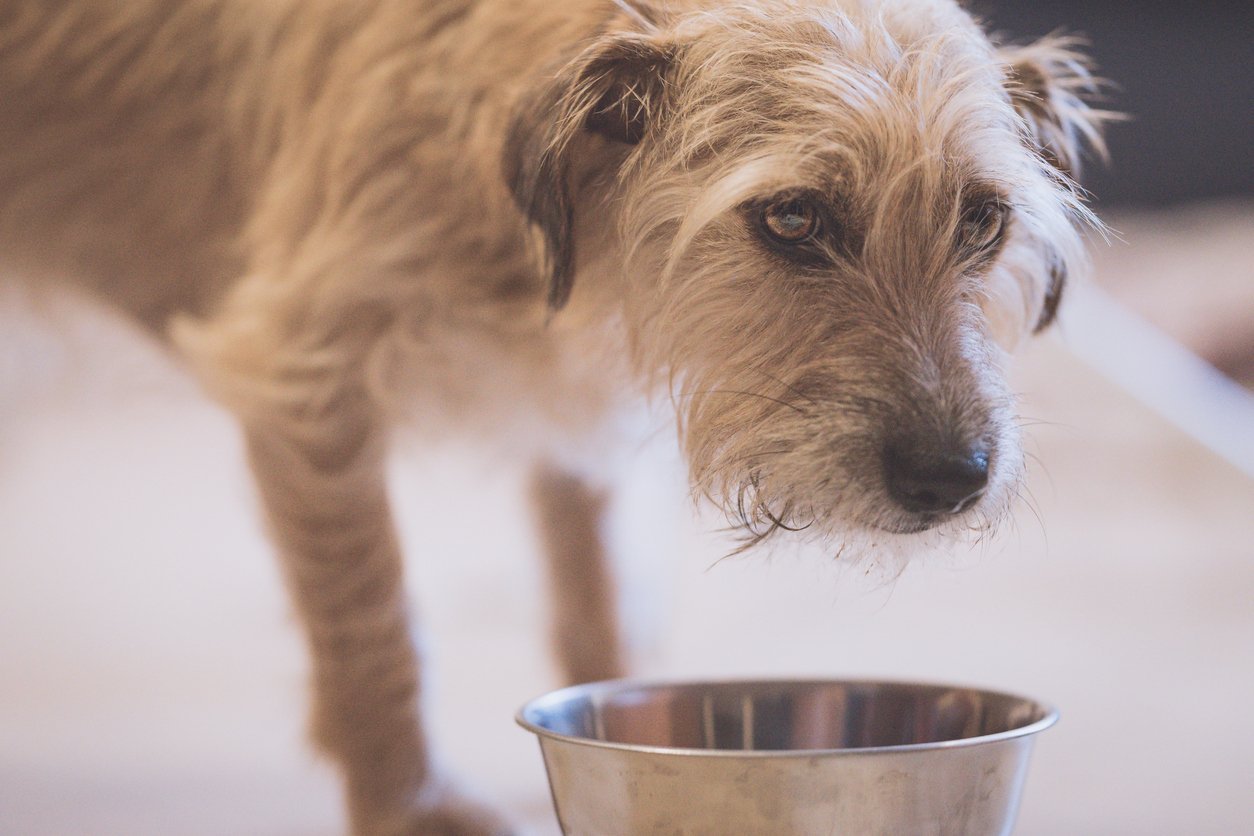
Our old dogs. We love them. And we want to make them comfortable in their senior years.
That’s why some pet owners may turn to a raw food diet for senior dogs. While we’d like to think they will live forever, when dogs are in the last 25% of their lifespan, they are considered senior and need special nutrition.
They exercise less and rest more often, so they need fewer calories than a growing puppy does. Plus, conditions like arthritis can set in, and additions to their diet need to be made accordingly. Glucosamine for dogs is a helpful addition to any senior dog diet, as it helps reduce symptoms and causes of arthritis.
Aiming to reduce calorie consumption by approximately 20-30% in mature and senior dogs no matter what you are feeding them is key. And when it comes to a raw food diet for dogs in their golden years, choose fish and other sources of omega-3 fatty acids that support brain function and delay cognitive decline.
Seniors also need to ensure they are getting enough hydration. Wet foods, and by extension, raw foods, definitely help prompt your dog’s thirst cues. Be careful to provide low-sodium foods with good quality sources of protein to avoid kidney problems as well as hypertension.
Raw Food Diet for Senior Dogs Keys to Success:
- Control calorie intake and avoid excess nutrients
- Add in brain-boosting foods
- Keep your dog hydrated
- Reduce sodium intake and increase protein quality
Raw Food Diet for Dogs with Allergies
Even dogs get allergies sometimes!
Allergies can be a reason owners seek out a raw food diet for dogs to begin with. From food sensitivity to skin reactions, you may need to eliminate many of the ingredients in commercial pet food. Grains, corn, soy, and other common fillers can also be common allergens for your dog.
In order to avoid these irritants to your dog’s system, you can opt for a raw dog food diet that allows you to control what is in your dog’s food and eliminate allergens. Just keep in mind that certain allergies may require your dog to take a prescription diet of hydrolyzed protein. A dog’s immune system doesn’t react to proteins that are broken down by hydrolysis the same way they would by consuming whole proteins like meat.
That said, the ideal raw food diet for dogs with allergies would be a one-to-one ratio of alternative protein such as salmon, duck, or venison with one alternative carbohydrate like sweet potato. It should also be grain-free to avoid problems for celiac dogs.
Raw Food Diet for Dogs with Allergies Keys to Success:
- Hydrolyzed prescription diets may be the safest option for your dog
- Pair 1 protein and 1 atypical carbohydrate to reduce allergen contact
- Go grain-free
Raw Food Diet for Dogs with Sensitive Stomachs
Some dogs are more sensitive to foods than others, especially when they are slipped some rich food over holidays or get table scraps not intended for their bellies.
Diets that are too fat-rich or lacking in fibre can cause digestive problems in dogs. Occasionally, digestive issues can be a sign of an underlying condition, such as pancreatitis, an overgrowth of bacteria, or even parasites.
By keeping the ingredients in your dogs’ diet limited and basic, you can avoid things being too rich or high in fat. Chicken and rice alongside some pumpkin to resolve stool looseness and upset stomachs. Additionally, foods like beet pulp can be good sources of fibre and can keep things moving smoothly for your pup.
Raw Food Diet for Dogs with Sensitive Stomachs Keys to Success:
- Stick to bland foods
- Offer your dog fibrous ingredients
- Keep low amounts of fat in the diet
Dog Food Raw Diet Considerations

So what is a dog raw diet made up of? And how do you decide what to mix up for your dog?
What your unique dog needs is up to their unique nutritional needs. Speak with your veterinarian about what they may need most.
In the meantime, we’re going to break down what exactly you need to consider when it comes to dog food raw diets.
Cost of Raw Food Diet for Dogs
Every pet food you choose will cost you money, that is one thing. No matter if it is wet, dry, or diet dog food – it costs you, and you’re going to have some options within each category that will typically fit your budget. Certain types of food (like dry food) can be cheaper overall, and others will almost always cost you more (wet food).
In terms of the cost of raw food diet for dogs, think of it like going to a fast-food restaurant versus a fine dining one, with kibble being the former and the raw food diet for dogs being the latter.
Dogs don’t eat raw for cheap. Raw food costs about $2 to $8 per day for a 50-pound dog, compared to $1 a day for kibble from the grocery store. That can be out of range for many pet parents, as much as we wish we could spend whatever we wanted to on our pets.
You can reduce raw food diet for dogs costs by buying in bulk, and getting meat on sale. You can also grow vegetables like carrots and green beans and feed them to your dog. Talk about farm to (dog) plate service!
Where to Buy Raw Food Diet for Dogs
Looking for where to buy raw diet food for dogs near you? You’re in luck – as the modern pet parent, you have access to plenty of options to feed dogs raw diets with ease. You can opt for a prepackaged raw food diet for dogs or subscriptions that offer a meal plan raw food diet for dogs.
There are three primary places to buy raw dog diet foods:
- Pet stores
- Online
- Raw food diet for dogs delivery subscription
If you are looking for dog raw diet foods that are already made and ready to serve to your pup, check out physical stores for refrigerated options made commercially. This can be seen as more convenient and safer in general, however, it may be expensive and can still be at risk for a recall as it is made commercially. These prepared foods can also be sent to your home via subscription service for serious convenience.
Ingredients in Raw Food Diet for Dogs Recipes

Fruits and vegetables may seem like a safe bet, regardless of which one you choose – but that is not always the case for your dogs. In fact, some fruits and vegetables are dangerous and even deadly to your dog.
Consult the handy tables below for information about which fruits and vegetables are safe and not so safe to include as raw diet dog foods.
Fruits safe and not safe to include in a raw food dog diet are listed below in the table.
| Fruits Safe for Raw Diet Dog Food | Not Safe for Raw Diet Dog Food |
|
|
Vegetables that are safe and not safe to include in your raw dog diet is outlined in the table below.
| Vegetables Safe for Raw Diet Dog Food | Not Safe for Raw Diet Dog Food |
|
|
Joint Supplements for Dogs on Raw Food Diet
No matter the diet your dog is on, you need to make sure you’re doing the most you can to prevent painful conditions like arthritis from taking the pep out of your furball’s step.
That means finding a joint supplement that can be added to their diets with ease. For raw food diets, you want something simple, flavourless, and easy to sprinkle on to or into a dog’s food. But you don’t want any old dog supplements. No – you need a dog food supplement that is trustworthy and most of all has a high-quality ingredient list.
One name you can trust? Integricare’s TRI-ACTA for pets. Both our regular TRI-ACTA and TRI-ACTA H.A. contain valuable ingredients that supplement a raw food diet for dogs with ease. Plus, with no fillers and 100% active ingredients this product is a paw-fect way to protect your dog from the pain of arthritis and help them stay healthy and active alongside a raw food diet plan for dogs well into their golden years.
TRI-ACTA for Pets
A proactive approach for developing and younger adult pets to maintain optimal joint health mobility, minimize inflammation and fend off age-related ailments.
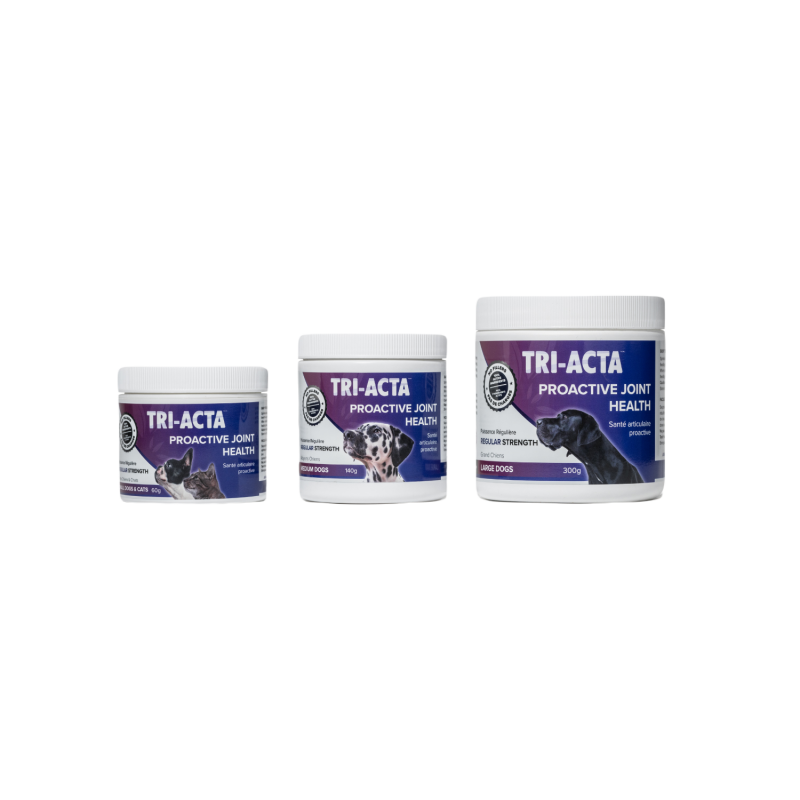
Conclusion

Every dog has unique needs. And sometimes, the best way to meet those unique needs is to feed them a raw diet food for dogs. You can create and craft blends of hearty, whole ingredients that support healthy vitality.
Whether you’re considering a raw food diet for dogs with sensitive stomachs or one focused on tackling age-related issues such as arthritis, supplement their diets with a joint supplement like Integricare’s TRI-ACTA for pets.
Our product gives your dog 100% active ingredients, with no fillers, and a small serving size. For pups on a raw food diet for dogs with allergies, that can be ideal, as you don’t have to worry about having an uncomfortable reaction to grains, corn, soy, or other allergens that happen to be common fillers. Plus, when you’re working towards treating conditions like arthritis through nutrition, a joint health supplement containing glucosamine, chondroitin, and MSM can help amplify the benefits of a good diet and exercise.
Now that sounds like a solution we can all agree on!
TRI-ACTA H.A. for Pets
Our maximum strength formula is optimally designed to accelerate the formation of cartilage, minimize inflammation, expedite the healing process, and improve joint conditions.

Newsletter Signup
Subscribe to our newsletter to receive the latest news and exclusive offers.
.jpg?height=2000&name=Cliick_Integricare-DISPLAY-REVISEDV2%20(1).jpg)
Proactive & Therapeutic Joint Supplements
When given daily, Integricare joint supplements recover bone and joint injuries faster and help prevent mobility injuries from happening in the first place.

